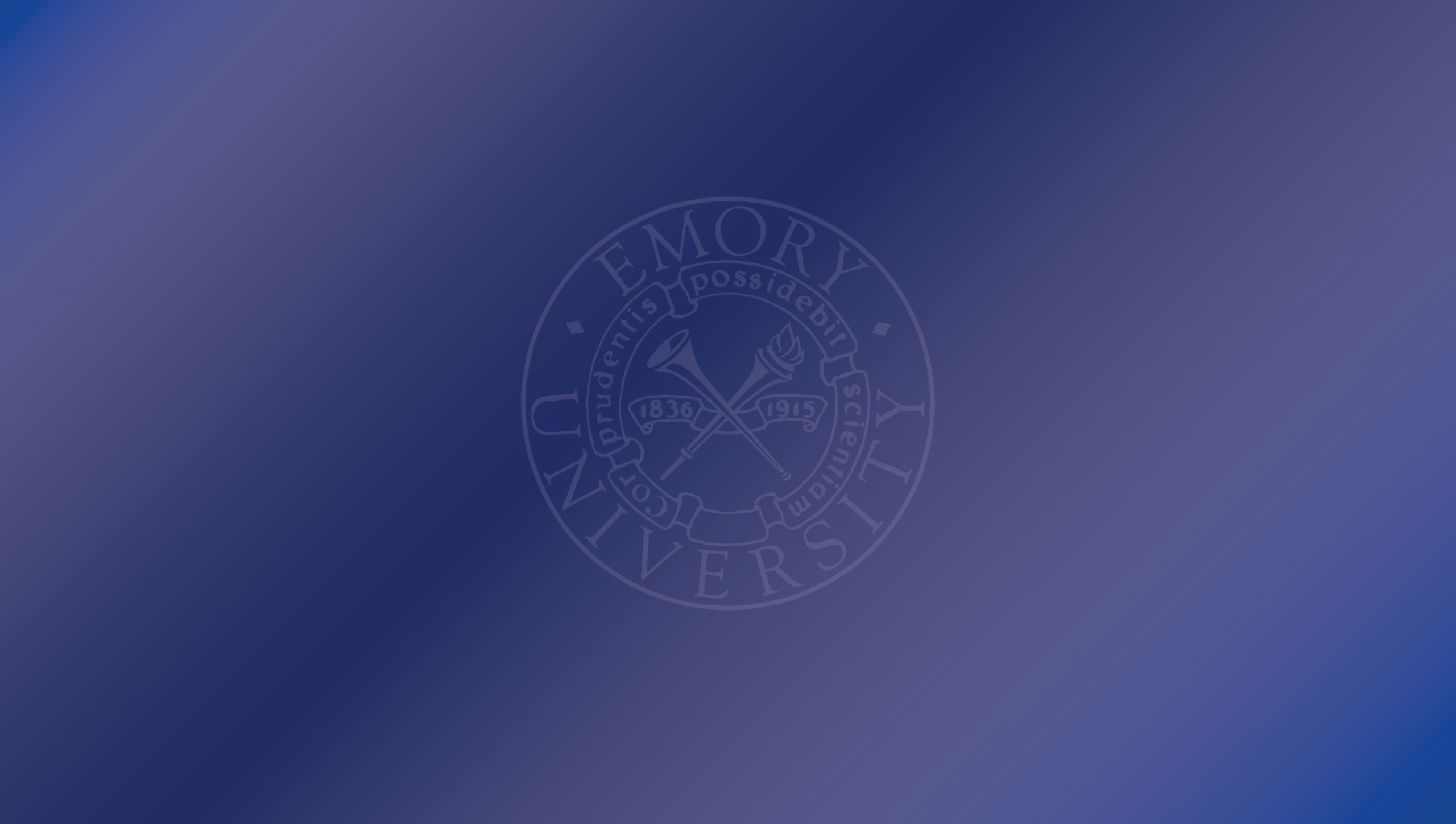Charting Emory’s Future
In his first address, President Fenves outlines goals and strategies to increase the university’s impact
Emory President Gregory L. Fenves gave his first address to the Emory community March 23, praising the perseverance and innovation of faculty, staff and students throughout the COVID-19 pandemic and providing updates on actions to support equity and inclusion, faculty eminence and student experiences across the university.
Fenves took the helm at Emory on Aug. 1, 2020. “Eight months is a short time for a university founded 185 years ago, and really, a short amount of time for anything important — except for delivering an inaugural address,” he acknowledged in remarks to the University Senate livestreamed for the entire Emory community.
Although he first planned to address the community early last fall, it felt too soon: “I needed to listen. I needed to understand all that makes Emory distinct. And we all needed to get through some of the most difficult days in our university’s history.”
When everyone returns to campus next fall, Fenves said, Emory will plant two trees — one on the Atlanta campus and one on the Oxford campus — to honor the resilience of the university’s students, nurses, doctors, researchers, front-line workers, faculty members and alumni, as well as the city of Atlanta.
“You might ask: Just two trees to symbolize all of that? … But you know, a forest starts with one tree, and then a second, and then it grows from there. And that’s the spirit we want guiding us in the months ahead,” he said. “One step, one kind moment, one action at a time on the road not only to a return to campus, but to reimagining and reinventing.”
Confronting COVID-19
Fenves turned to Emory’s mission — “to create, preserve, teach and apply knowledge in the service of humanity” — to discuss the university’s response to COVID-19.
- Create: Emory researchers and physicians created new knowledge through breakthroughs like helping develop and test the Moderna vaccine, treating patients and advocating for health equity.
- Preserve: Emory was better able to lead through this crisis due to efforts like a conference held by Rollins School of Public Health and the CDC to commemorate the anniversary of the 1918 flu pandemic that looked at the past as well as preparedness and prevention.
- Teach: When Emory transitioned to remote learning, faculty and graduate instructors quickly developed new ways to teach and connect with their students.
- Apply: All of this was made possible because the Emory community applied knowledge to keep the campus community healthy, including following health guidelines and on-campus students participating in twice-weekly testing this semester. These steps, combined with the increasing availability of vaccines, will allow Emory to fully return to campus in the fall.
Advancing racial and social justice
“But as we plan for tomorrow, we also need to take a look at ourselves and our values as a university,” Fenves said, transitioning to discuss the other pandemic at the forefront for the university and the nation this year: racial and social injustice.
“Emory was founded in the American South before the Civil War on Muscogee lands. The legacy of human enslavement and subjugation is part of Emory’s history. This was a segregated institution by law and tradition for a longer period of time than it has admitted African American students…
“These truths are a part of our history,” he said. “We must speak about them and understand them, and we must also realize that we have a responsibility to evaluate ourselves and continually make improvements as we move forward.”
Crediting the work of students who are leading the way to a more just, inclusive and equitable Emory, Fenves recounted several actions underway from the racial and social justice initiatives he announced in August and updated the community about in October.
- Recharging the Taskforce on Untold Stories and Disenfranchised Populations, which is preparing recommendations to honor enslaved persons who built Emory, establish scholarships for their descendants and acknowledge the contributions of indigenous people, among other actions;
- Reappointing the Committee on Naming Honors to review contested historic names and consider other names for buildings and celebratory titles;
- Renovating campus identity spaces to provide a welcoming place for students; and
- Leading a discussion on policing at Emory to build trust between the community and the Emory Police Department that protects and serves the campus.
Reports are due from the task force and committee this semester, identity space renovations have started, and Emory has also now officially joined the Universities Studying Slavery Consortium. He also highlighted the landmark scholarship of Emory faculty on issues related to racial and social justice: “They have been the leaders our nation has turned to time and again.”
Emory’s vice provost for diversity and inclusion, Carol Henderson, has charged seven diversity, equity and inclusion communities with helping to develop a strategic plan that will be shared with the Emory community this fall.
“At its essence, One Emory is about putting students at the center of all we do. It’s about research and creativity that is innovative and integrative. It’s about a workplace where staff thrive, and it’s about Emory’s role as a vital thread in the interwoven fabric of the city of Atlanta.”
— President Gregory L. Fenves

Building on ‘One Emory’
Looking to the future, Fenves drew on the “One Emory” motto of the university’s strategic framework.
“At its essence, One Emory is about putting students at the center of all we do,” he said. “It’s about research and creativity that is innovative and integrative. It’s about a workplace where staff thrive, and it’s about Emory’s role as a vital thread in the interwoven fabric of the city of Atlanta.”
Unlike universities, the world isn’t divided neatly into divisions and departments, so “One Emory” means reducing bureaucracy, incentivizing partnership and promoting interdisciplinary work.
That starts with supporting Emory’s excellent, diverse faculty to be eminent scholars and teachers. “I want people to ask: What does Emory think? We want the research of our faculty and graduate students to be impactful and also at the vanguard, leading the way and intertwining with other disciplines,” he said.
To further strengthen Emory’s academic mission, Fenves and incoming Provost Ravi Bellamkonda, who starts July 1, will partner with deans and faculty to invest in programs where Emory has unique advantages, opportunities and expertise. They will also invest in undergraduate, graduate and professional programs and strive to improve faculty diversity and retention.
“Eminent faculty seek great students at all levels — undergraduate, graduate and professional. And great students want to come to a university with inspiring professors who can challenge and motivate them,” he said.
Improving student experiences
Emory College of Arts and Sciences and Oxford College should be the first choice for talented students of all backgrounds from around the world, Fenves said, so Emory will strive to create a superlative undergraduate experience and improve the percentage of students who complete their degrees. He set a goal of increasing retention of first-year students to 97% in three years, when it has been as low as 93%.
Instead of just focusing on recruiting first-year students to come, Fenves said he wants the university to “re-recruit” current students by offering “those life-changing moments … when a student’s world opens up and they realize all of the potential they have within them.”
The president also committed to improving experiences for graduate and professional students, with a focus on building supportive, inclusive communities to help them fulfill their education without feeling isolated; improving retention, placement after graduation, and the time it takes to complete their degrees; and working to develop solutions to lessen the debt many take on.
A campaign for the university’s future
Building upon the “One Emory” framework also means focusing on Atlanta, Emory’s home, and encouraging staff across the university to build deeper connections so they can inspire each other and generate ideas to improve the university, Fenves said.
“As a leading institution in this city, we have an obligation to serve and so many incredible opportunities to collaborate and engage,” he said. “It is a place to learn from and contribute to. It is where our ideas take shape and come to life. And I look forward to working with the faculty, our dedicated students, and of course, our incredible staff to build lasting connections here.”
Later this year, the university will announce its next comprehensive campaign — intended as “a North Star for Emory’s future” — to garner resources to invest in the university’s commitments to both students and faculty. “This will be a campaign for our future,” he said. “This will also be a campaign to live up to our highest calling as a university: ‘to create, preserve, teach and apply knowledge in the service of humanity.’”
The Emory family
The address concluded with a quote from the novel “An American Marriage” by Tayari Jones, Emory’s Charles Howard Candler Professor of English and Creative Writing: “I don’t believe that blood makes a family. Kin is the circle you create, hands held tight.”
For Fenves and his wife Carmel, “it is the honor of our lives to be a part of Emory,” he said. “I look forward to the day not far from now when we can greet each other in person, as a university, as the Emory family.”

